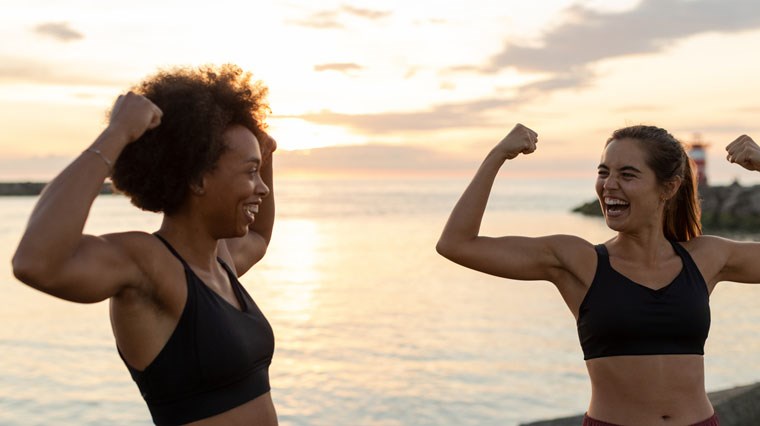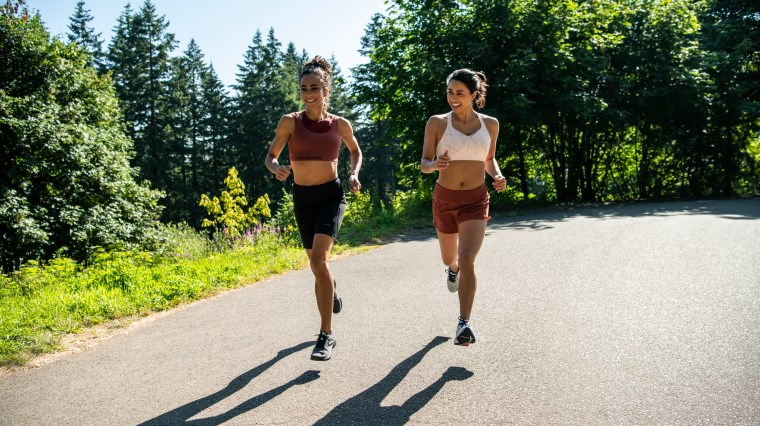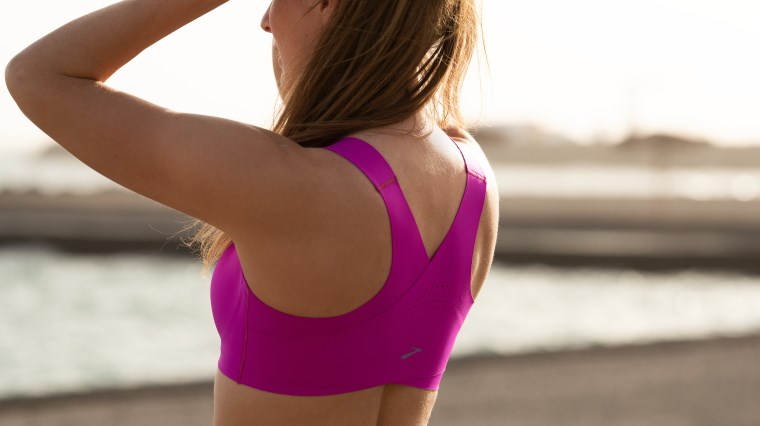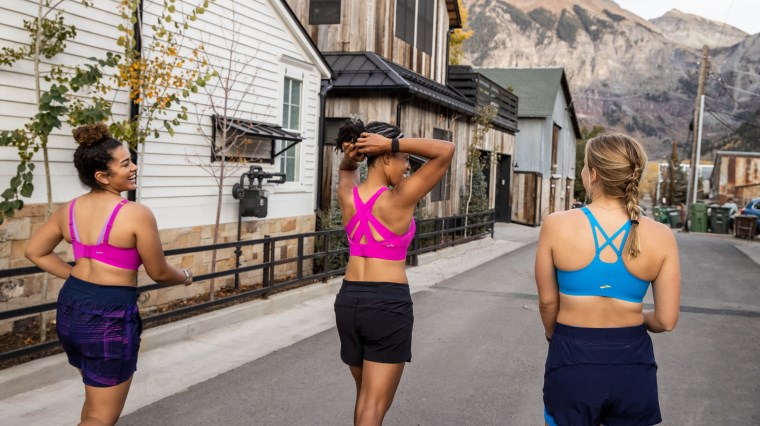Part 1: How To Choose A Sports Bra To Support Breast Health

As runners, we know that running takes its toll – on our feet, knees, hips and yes – our breasts. Inspired by the Brooks new range of Run Bras, Sportitude Running is putting the spotlight on breast health for female athletes to perform better in terms of both confidence and comfort.
In this 2-part series we’ll highlight not only what a sports bra can do for you, but why a running bra specifically is an essential piece of equipment in your running kit.
Just like running shoes, there’s no one-size-fits-all scenario for sports bras – and what’s best for you won’t be necessarily be best for your running buddy. Depending on your training routine, you may even benefit from having multiple sports bras in your rotation to deliver a level of support (low, medium or high) that best caters to the activity.
In this blog running bras are the star of the show - delivering high-impact support to empower women to run comfortably, distraction-free and without fear of long-term breast damage.
In Part 1 we'll talk about the benefits of a running bra for breast health, weight up compression vs encapsulation and do a breakdown of the key components of a sports bra. In Part 2 we'll provide guidance on what Brooks running bra is best for you. This will allow you to make healthy and informed choices to keep your breasts supported and running happy.
Your Breast Health: Why a running bra?

To understand the importance of a running bra, it’s valuable to know the anatomy of your breasts better.
Cooper’s ligaments
Finding the right sports bra for you is an important part in ensuring your breast health – providing external support to your breasts to take the pressure off your Cooper’s ligaments and protect the surrounding skin.
Cooper’s ligaments have a key role in connecting your breast tissue to your chest wall (pectoral muscles). Alongside your skin, these connective tissues are responsible for retraining the shape and integrity of your breasts. Essentially, they’re the natural internal support structures of your breast tissue.
Cooper’s ligaments are delicate, thin and susceptible to damage during high-impact activity like running. The repetitive and vigorous up-down motion puts them under excessive tension and stress, causing them to stretch. Imagine a rubber band stretched beyond its capacity and loosing elasticity over time, no longer able to spring back into shape. Of course, Cooper’s ligaments are much more complicated than that but the general idea is the same.
Damage to your Cooper’s ligaments not only can cause irreversible breast sagging, but breast pain and discomfort. Cooper’s ligaments naturally stretch (otherwise called ‘ligament creep’) as you age and during pregnancy, but there are ways you can take care of your breasts to prevent accelerating the process and to keep your Cooper’s ligaments healthy for longer.
The higher the impact (& heavier the breasts), the greater the support needed
Being high-impact in nature, running demands more from your running gear than a standard sports bra or everyday bra can offer, both in terms of support and comfort. Your breasts move independently from the rest of your body – and you probably know the feeling of your breasts having a ‘mind of their own’ when you’re jogging upstairs or running without adequate support. A supportive running bra is critical to minimise excessive breast movement which can damage and stretch breast tissue in multiple directions.
Aside from the risks to breast health as discussed previously, running with inadequate support can also throw off your performance – causing you to move less efficiently and interfering with proper running form. This is particularly the case with heavier breasts that when poorly supported, can result in neck and back pain or cause strain to your shoulders and back as you rely on your upper body for support. In terms of your running posture, this can cause you to slouch forward uncomfortably with the unsupported weight of your breasts.
Due to the increased mass of breast tissue of fuller breasts, women with larger cup sizes may benefit from using a higher-impact sports bra even for less strenuous activity such as walking and yoga. No matter the size or shape, all breasts benefit from wearing a running bra – empowering you to move and stopping bounce from being a barrier to exercise.
The Anatomy Of A Sports Bra

The best sports bra is one that essentially you can throw on and forget about, offering a distraction-free, stay-put fit that let you focus purely on the road ahead. Of course, there is no perfect ‘cookie-cutter’ sports bra and your choice should purely be personalised to you and the stage of life your breasts are at!
Every sports bra is different, so it’s important to read the product description or garment tag to identify whether it is best suited to providing low-impact support (e.g. yoga, Pilates, walking, strength training), medium-impact support (e.g. light jogs, road cycling, hiking) or high-intensity support (e.g. running, HIIT, mountain biking).
Below we’ll answer the big question of compression vs encapsulation, as well as dive into key aspects of your running bra anatomy, being cups & padding, straps, bra band, fabric and closure style to give you food for thought when you read our Essential Guide To Brooks Running Bras in Part 2.
1. Compression vs Encapsulation
One of the key elements that may influence your running or sports bra choice is whether the support is compression-based or encapsulation-based.
Compression
Compression sports bras hug or ‘compress’ your breasts close to your chest, specialising in limiting horizontal (forward-backward) breast movement.
High-impact compression sports bras are a go-to option for many women with smaller to moderate bust sizes to run at any distance or pace. For fuller bust sizes (D cup and larger), compression sports bras are better saved for walking, yoga, light jogs or easy-going recovery sessions.
If going down the compression running bra road, women with fuller bust sizes should generally choose one with adjustability in the bra band and straps for more customised support.
Key points:
- Provides support by holding breasts close to chest to limit multi-directional bounce, particularly the in-out movement of breasts during your runs
- Versatile option for smaller to moderate bust sizes (A-C cup)
- Larger bust sizes (D and up) should seek a compression bra that offers adjustability for more customised support and choose an encapsulation sports bra when performing high-intensity activity
- Expect a snugger-feeling fit in compression sports bras compared to encapsulation sports bras
Encapsulation
Along with the majority of everyday bras, encapsulation sports bras support each breast individually, lifting and separating to provide a contoured, more natural shape and structured fit compared to compression-based options. However, this does not mean your everyday bra is up to the task of a running bra – they’re simply not designed to handle the forces upon your breasts during physical activity. Protect your breasts by choosing the right bra for the job.
Although your breasts will sit more further out from your chest when wearing an encapsulation sports bra compared to a compression sports bra, encapsulation styles limit a wider range of breast movement more effectively - vertically (up-down), lateral (side to side) and horizontal (forward-back). They distribute the weight of your breasts more precisely rather than addressing your pair of breasts as one (which can lead to the ‘uniboob’ look of some compression styles).
Cradling each breast this way makes encapsulation sports bras ideal for high-intensity activity for any bust size, providing protection against multi-directional breast movement during running, plyometric training (explosive movements or jumping) and other activity where beating the bounce is essential to breast health.
Key points:
- Ideal for all cup sizes and workout intensities – for running choose a high-impact style that works for you
- Reduces multi-directional breast movement effectively in all three dimensions – in-out, up-down and side to side
- Cups breasts individually
- Provides more targeted support to each breast
- Separating breasts decreases chafing during activity, particularly for fuller bust sizes
2. Cups & Padding
Like female athletes, sports bra cups come in all shapes and sizes. Of course, naturally their shaped to fit your breasts, but they vary in terms of whether they’re in-built, removable, or non-existent with more minimalist styles of sports bra like the Brooks Drive Interlace.
Removable styles of course offer more adaptability to customise the coverage while in-built styles give you peace of mind knowing they’ll stay-put and not escape in the wash.
Not only are cups responsible for providing coverage and support, but they can shape the look of a sports bra – some offering a more ‘crop top’ style and others enhancing shape with a moulded fit or additional padding.
3. Bra Band
The bra band does its fair share of heavy lifting in terms of providing the most support. It’s the base of the sports bra, wrapping firmly to your rib cage beneath your breasts.
What do you want out of a bust band? Wirefree bust bands should be snug-fitting, soft and wide for a supportive fit. Some sports bras feature an elongated bra band for extra coverage and a more locked-in feel. Innovative design in modern sports bras in terms of fabric and structure mean wirefree bust bands like many members of the Brooks Run Bra range can offer equivalent support to underwire styles.
Encapsulation sports bras may use an underwire integrated into the band to assist in supporting breast weight evenly. The term ‘underwire’ may cause some of us to cringe that have heard horror stories of the wire breaking through and pinching breast tissue, but quality designs have a degree of flexibility for a sturdy yet adaptable fit to cater to your movement.
4. Straps
The modern runner has so many options in terms of sports bra straps – from racerback designs like the Brooks Dare Racerback 2.0 to interlacing straps of the Brooks Drive Interlace running bra. Straps can be a key part in providing bounce-reducing stabilisation, so the style of straps do make a difference.
When hunting for a run-ready straps, the width is often a suggestion of the level of support they provide, with wider straps providing more support and catering to higher-impact workouts. The straps should be smooth against your skin to avoid pinching or digging in. Adjustable straps allow you to personalise the fit.
Conventional straps
Regular or conventional straps curve over your shoulders and go straight down your back vertically, connecting to the bra band often in a ‘U’ shape without the left and right strap meeting mid-back. It’s worth considering for runners that want a strap style that more closely resembles the easy on/off of an everyday bra. Some conventional straps can convert into crossover styles for more discreet coverage beneath running tank tops.
Crossover / criss-cross straps
Crossover straps meet at your back in an ‘X’ shape, providing excellent support and a stabilising feel – essentially a happy medium between a conventional, vertical strap design and a racerback. The Brooks Dare Crossback 2.0 running bra is a great example, featuring a slit on one of the straps for the other to slide through, creating a smooth and bulk-free feel against your back.
Racerback straps
Racerback straps meet at your back in a ‘Y’ shape and are the go-to for many runners as they’re uncomplicated, practical and effective at providing ever-reliable support. Racerback designs allow your arms to pump freely and offer a non-slip fit so you don’t have to constantly readjust on-the-run. For some runners, the challenge with racerback styles is simply getting them on! However, if you take the time to contort into a fixed racerback, the support is unbeatable like the Brooks Drive Pocket running bra. The Brooks Dare Racerback 2.0 features an adjustable back clasp to make it that bit easier.
‘Strappy’ back
Of course comfort and support is first and foremost, but you also want a sports bra that you feel good in and that you’ll come back to for those feel-good vibes – rather than leaving it tucked away at the back of a drawer. Sports bras with multiple pairs of intersecting straps at the back are more of a style choice, keeping in mind that more straps doesn't necessarily mean more support. The Brooks Drive Interlace running bra provides a blend of both support and style with it's shock-absorbing design. It’s all about finding a bra that works in harmony with your workouts and what you want to get out it.
5. Fabric: Breathability & Sweat Control
The fabric essentially is the ‘skin’ of the sports bra – so you want it to be durable, soft and supple, with just-right stretch to accommodate your movement while providing support. That may sound like a lot to ask from run-of-the-mill cotton fabric – and that’s why sports bra are made specifically of performance materials.
These performance materials like the DriLayer HorsePower fabric of the Brooks Run Bra range, are sweat-wicking and fast-drying to keep your breasts in a healthy and dry environment. Breathability is provided through perforations or strategically placed mesh panels in sweat-prone zones like in-between the breasts, as featured in the Brooks Drive Plunge running bra. These breathability features allow air to flow freely, preventing the build-up of sweat and heat to keep you feeling fresh for longer while maximising comfort.
Fabric with minimal or bonded seams also contribute to a buttery-smooth, distraction-free fit and prevent any pinching, irritation and painful chafing.
6. Closure Style: Pullover vs Adjustable Back Clasp
Pullover sports bras provide a smooth, no-fuss fit, often being free of adjustability features like metal clasps that have the potential to dig in and irritate the skin. The challenge of the pullover sports bra is in getting it on – and it may take a little ‘dance’ or contortion act for you to get it over your breasts correctly. If you’ve ever had a panic moment trying to put on a pullover sports bra and getting stuck halfway – we can assure you that you’re not alone!
Once they are on however, if properly fitted they provide a secure, confidence-inspiring feel to unleash your inner runner. If you choose a non-adjustable sports bra, it is crucial that it fits correctly as there is no option to tweak the fit. Also, it’s important to be aware that during life changes like pregnancy, these styles will not provide the adaptability to grow with you.
Sports bras with adjustable hook-and-eye closure allow you to put the sports bra on more easily. They also save you from having to peel off a sweat-soaked bra over your head after a rigorous run. Well-designed styles will feature soft fabric between the clasp and your skin when fitted to protect against irritation.
Some pullover styles like the Brooks Dare Racerback 2.0 also feature an adjustable back clasp on the bra band, providing a little extra wriggle room in terms of fit. In terms of whether pullover or adjustable clasp styles are best, it all comes down to personal preference.
The Wrap Up

All-up you want a sports bra that you feel good in – ticking your boxes for comfort, support and confidence in your own skin – and that will fundamentally preserve and protect your breast health during physical activity.
Read on to Part 2: A Guide To Brooks Running Bras to find the best sports bra to match your body and your running goals.
Happy running!
